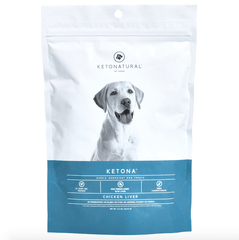Save Money, Save Your Dog.
Join Our Email List For Discounted Pricing and a Free Guide to the Science of Keto Dog Food.
More and more pet owners are turning to raw and natural ways to help their dog’s dental health versus grabbing a bag of chewies that often contain artificial ingredients and flavors. Let’s chat about one way to keep your dog’s teeth healthy and clean - raw bones!
NOTE: Consult your veterinarian before introducing raw bones to make sure there are no health hazards such as the size of your dog, metabolic conditions, or dental issues. You will want to avoid giving your dog bones if she has soft, broken, or loose teeth.
Dogs have been using raw bones alongside their all meat diet for most of their evolutionary timeline, dating back to when they were gray wolves. Raw bones act as a nature made scraper that removes plaque and tartar that in turn helps with bad breath!
Raw bones also can be a natural source of calcium and phosphorus. Now that’s something to gnaw on!
Here is a quick and easy guide on how to get started on using raw bones for dental health:
What type of raw bones should I give my dog?
Depending on the size of your dog, knucklebones from large mammals (beef, bison, venison) are the safest option.

Other great options are small lamb ribs, longer beef ribs, and lamb shanks.
Remember that you are searching for "raw" bones only so that means that the end product was not cooked, steamed, boiled, baked or smoked!
How big should the raw bones be?
In general, you don’t want the bone to be larger than the size of your dog’s head. In reality, there is no such thing as a too-large bone, but there are definitely bones that are too small for some dogs.
A good rule of thumb is to make sure that the entire bone cannot fit fully into your dog’s mouth. You also want to avoid a trip to the ER and avoid a bone that has an opening large enough for your dog’s lower jaw.
In addition to choking hazards, too-small bones can also cause significant oral trauma (including tooth fractures).
Where can I find raw bones?
The freezer section of your neighborhood independent pet store should have a selection of raw bones, and knowledgeable staff will help you choose the right size.
It is possible to find raw knucklebones in your local meat counter of your supermarket (sometimes called soup bones and found in the refrigerator or freezer section) if there is no independent pet store near you. Pop the bones in the freezer as soon as you get them home. Once they are thawed, give them to your dog one at a time.
How often should I give my dog raw bones?
Raw bones should be offered in 15-20 minute increments twice weekly for best plaque fighting results.
Tossing your dog a bone always requires supervision. Monitor for any signs of gagging, choking, or mouth injury. Store bought dental chews are typically very soft so slowly introduce this new form of dental cleaning and your dog will love you for it!
Should I give my puppy raw bones?
Always consult with your veterinarian, but the best response is no. Puppy's teeth are too small and the choking hazard is too high to tackle raw bones. Try soft items like cotton rope or firm fabric covered toys. They need to learn how to chew a variety of shapes and sizes until they are ready to tackle a raw bone.
What type of bones or dental chews should I avoid?
Always make the right choice for your dog(s), but here is a list of what to skip at the pet store or butcher shop:- Cooked or smoked bones
- Commercially prepared dental chews, especially the green ones!
- Any rawhide products including big ears, cow noses, bully sticks, antlers, nylabones, or plastic chews, etc.
- “Dental” chews found in pet or grocery stores with rice, glycerin, flour, etc are not high-quality bones
- Pork neck bones – have caused esophageal impactions
- Land mammal weight-bearing bones: tibias, fibulas (hind limb), radius and ulna (forelimb). These are prone to breaking, have sharp ends, and are slow to break down in the stomach
- Marrow bones - the large amount of fat in many can be problematic for some dogs. With larger diameters, eager/aggressive chewers easily generate enough force to crack teeth.
What if I don't have access to raw bones?
If raw isn't an option, opt for air dried or freeze dried single ingredient chews such as tracheas, chicken or duck necks, duck heads, chicken or duck feet, salmon skins, etc.-which can be found in the 'raw bar' section of your local independent pet retailer.


Related Articles
12 Warning Signs Your Dog is in Pain and How to Help
6 Signs Your Dog Needs Joint & Mobility Supplements
How to Spot When Your Senior Dog is in Pain
New Year, New You: But What About Your Dog?
Browse Articles By Category